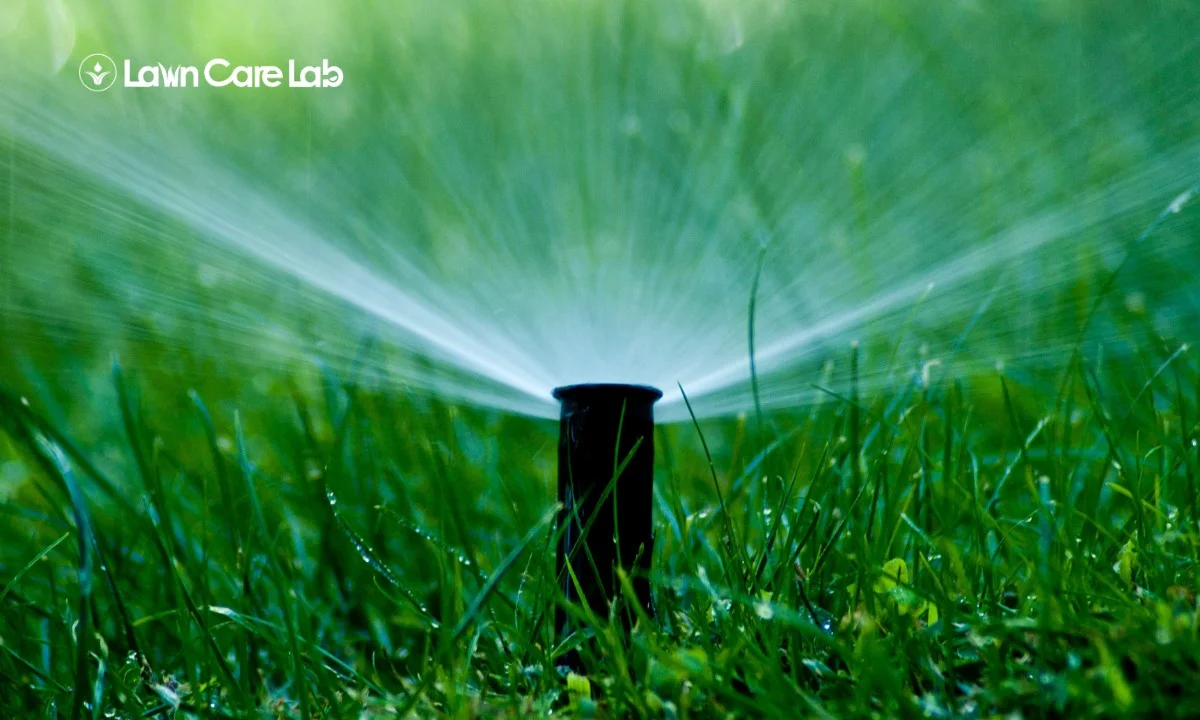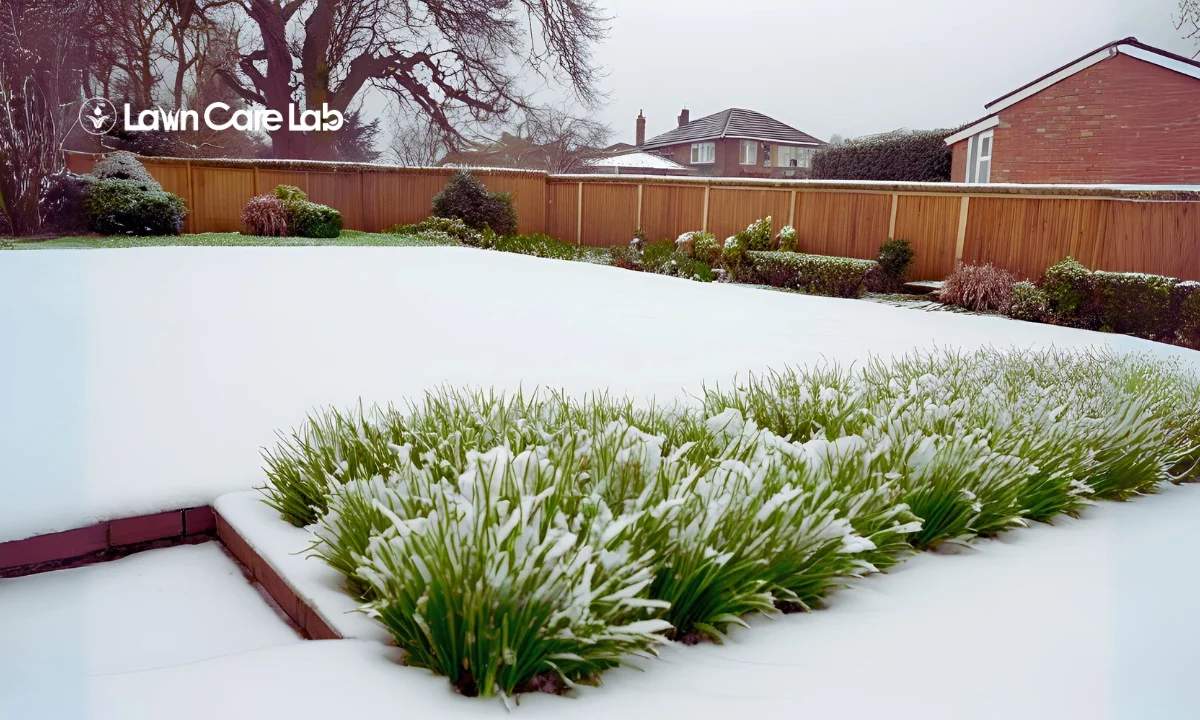As winter draws nearer, it’s easy to forget about lawn care. But it’s important to remember that taking some preventive steps now can save you from costly repairs later.
Watering lawns during the winter can save you from multiple issues like crown desiccation, winter burn, root hydration issues, warm spell damage, snow mold, winter fungus outbreaks, and winter desiccation of young landscape plants.
To protect your lawn this winter, take a few minutes to understand the importance of winter watering.
Table of Contents
Preventing Crown Desiccation and Winter Burn
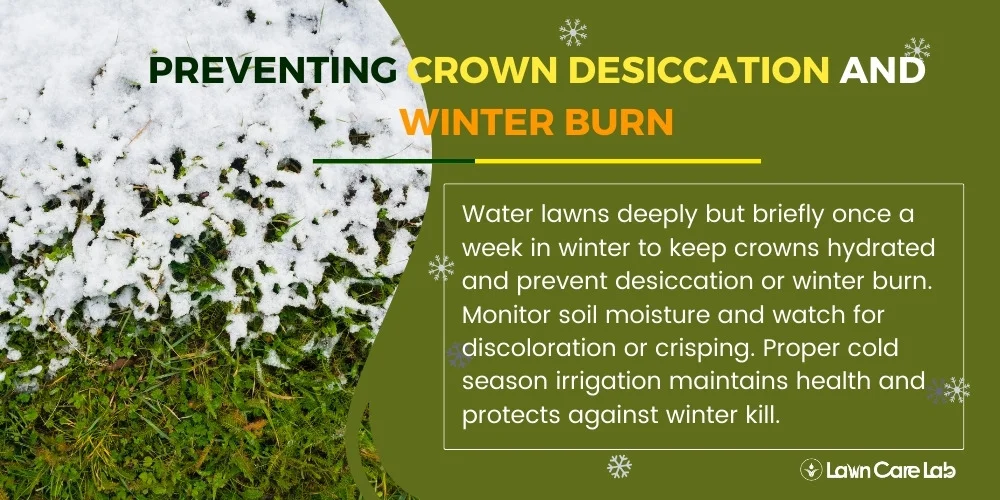
Water your lawn deeply at least once a week to prevent winter damage from desiccation, especially on sunny and windy days.
Hydrate crowns in colder months. Watch for discoloration; water more if needed.
Proper care ensures that your lawn can remain lush and healthy all winter.
Crowns Lose Moisture During Dormancy
Keep your lawn’s crowns moist by regularly irrigating and monitoring soil moisture to avoid winter burn and crown desiccation.
Additionally, applying mulch can help keep moisture locked in and reduce water loss.
Keeping up with these simple winter lawn care tips can help maintain your turf’s health and protect it from winter kill.
Brief Deep Watering Rehydrates Crowns
Water your lawn with short, deep watering sessions during winter to prevent desiccation and maintain its health.
Here are some tips to help you get the most out of your winter hydration efforts:
- When watering your lawn, monitor weather conditions like wind, temperature, and time since the last snowmelt.
- Ensure you reach the crown and soil beneath it, watering to a 4-6 inches depth for 30-60 minutes.
- Monitor soil moisture levels to ensure your lawn isn’t drying out.
- Avoid overwatering, as this can damage the roots and cause long-term issues.
Signs of Winter Burn Signal Need for Irrigation
Protect your lawn during winter by taking preventive measures. Signs of winter burn include browning crown tissue, crisping blades, and thinning turf.
Here are some tips to help you combat winter burn:
- Watering before winter prevents burn and hydrates grass crowns.
- An insulation layer of straw, leaves, or mulch can also help protect the grass from the cold weather.
- Fertilizing in the fall provides extra nutrients for the grass to sustain itself throughout the cold season.
- Choose a grass variety suited to your climate to minimize winter burn.
Maintaining Root Hydration for Spring Regrowth
Don’t forget to water your lawn’s roots during winter, even if the grass is dormant. It’ll help them stay healthy and prepare for spring growth.
Roots Remain Active Despite Foliar Dormancy
Winter may leave your lawn dormant, but keeping the roots hydrated is essential for healthy regrowth in spring. Cool-season grasses absorb water through their white roots in the soil to avoid dehydration.
Check soil moisture regularly for root health. Avoid watering in winter unless there is no precipitation.
Keep your eyes peeled for wet weather forecasts, and you’ll help ensure a lush and vibrant lawn in the spring.
Water Replenishes Subsoil Moisture for Root Uptake
Deep winter irrigation is crucial for a healthy lawn. Watering at a 6-8 inches depth keeps roots hydrated, replenishes moisture reserves, and ensures growth in dry winter months.
An inch of water per month during winter can help your lawn recover from dormancy and prepare for regrowth in spring.
Well-Hydrated Roots Initiate Healthier Spring Growth
Winter lawn care is vital for a healthy spring lawn. Keep roots hydrated and provide nutrients to promote healthier regrowth. This will help your lawn absorb more water, fight drought, and look its best.
Here are four key benefits of keeping your roots hydrated during the winter:
- Encouraging winter root growth
- Stopping drought in its tracks
- Promoting early greening
- Enhancing water absorption
Combating Damage from Unseasonable Warm Spells
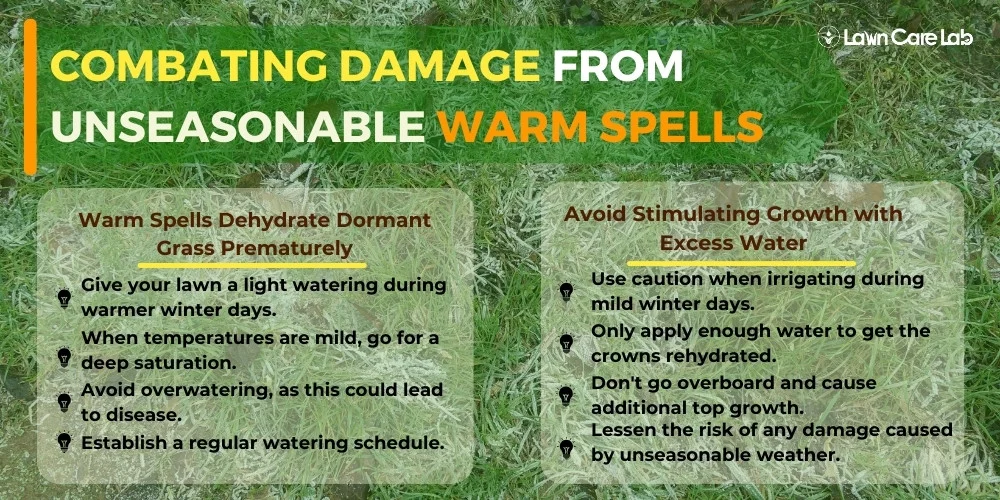
Winter warm spells can harm your lawn, especially if it’s been dormant. Dehydration can occur, leading to damage. But you can take steps to protect your grass.
Water your lawn lightly during warm days to prevent damage. Avoid overwatering as it can stimulate growth that harms the grass.
Warm Spells Dehydrate Dormant Grass Prematurely
Here are a few useful tips for preventing dehydration:
- Give your lawn a light watering during warmer winter days.
- When temperatures are mild, go for a deep saturation.
- Avoid overwatering, as this could lead to disease.
- Establish a regular watering schedule.
Avoid Stimulating Growth with Excess Water
Don’t overwater your lawn during warm spells. Only give it the minimum amount of hydration necessary to rehydrate its crowns. This will ensure healthy cold tolerance and root health.
Here are some tips to follow to prevent overwatering:
- Use caution when irrigating during mild winter days.
- Only apply enough water to get the crowns rehydrated.
- Don’t go overboard and cause additional top growth.
- Lessen the risk of any damage caused by unseasonable weather.
Controlling Snow Mold and Winter Fungus Outbreaks
Proper winter irrigation management protects your lawn from winter fungus and snow mold.
To safeguard against harmful pathogens during deep freezes, ensure the soil is completely dry. Avoid over-saturation and allow ample dry-down time.
Snow Mold Thrives in Saturated Winter Soils
To avoid snow mold and fungi-related diseases, take care of your lawn during winter. Regular watering is crucial to prevent damage caused by heavy debris and soil saturation.
Avoid overwatering to prevent snow mold outbreaks and promote healthy root growth.
Winter watering is essential to keep soil moisture at optimal levels, limit the spread of lawn diseases, reduce snow mold, and keep your lawn healthy during winter.
Proper Soil Dry-Down Prevents Disease
Proper soil dry-down prevents disease outbreaks like snow mold and winter fungus. Schedule the final deep irrigation of fall 2-3 weeks before the first frost to reduce wet conditions that can lead to pathogens.
Let Soils Drain Completely Before Deep Freezes Arrive
Maintain soil moisture levels in winter to avoid snow mold and fungus.
Here are four key elements to help you keep your plants healthy and safe in winter:
- Monitor soil moisture levels regularly.
- Water deeply but less frequently.
- Avoid watering plants in the late afternoon.
- Protect plants with a layer of mulch.
Preventing Winter Desiccation of Young Landscape Plants
Winter desiccation can be a major problem for newly planted trees in your landscape. Avoiding this requires some effort, but the payoff is worth it.
Monitor the soil moisture carefully, and don’t let it become too dry. During dry spells, it’s important to water the plants by hand or use micro-irrigation.
Following these steps should help your young trees survive winter and thrive in the long run.
Newly Planted Trees Struggle with Underdeveloped Roots
Young trees and shrubs have fragile root systems, making winter challenging for them. Proper watering techniques, like monitoring soil moisture, mulching, and protecting the trunk, are crucial for their survival.
Winter watering can give them the moisture they need to thrive.
Monitor Soil Moisture Around Shrubs and Saplings
To care for young landscape plants in winter, it’s important to regularly check soil moisture levels by sampling the soil 4-6 inches deep.
Water newly planted specimens regularly in winter to prevent drying out. Boost soil health by taking preventive measures such as regular irrigation.
Setting up a regular watering schedule will help to ensure drought resistance.
Hand Water or Use Slow-Drip Irrigation on Windy Sites
Hand watering and slow-drip irrigation effectively prevent winter desiccation of young plants on windy sites. Micro-irrigation is another efficient way to provide water directly to the root zone and keep the soil hydrated during colder months while allowing easy monitoring of soil moisture levels.
Slow-drip irrigation has several benefits – maintaining consistent soil moisture levels, preventing dehydration, and ensuring proper winter watering. It’s an easy and effective way to keep plants healthy and hydrated in winter.
Evaluating the Need for Winter Watering
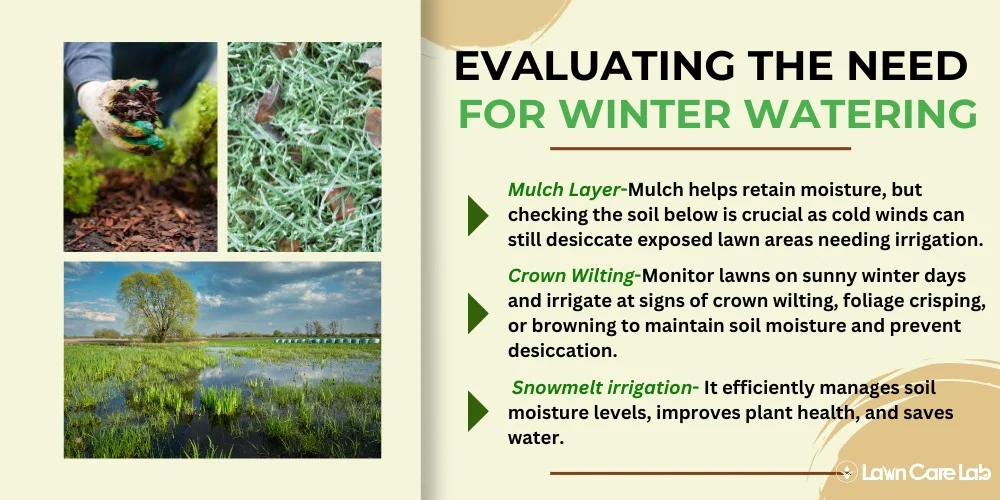
Check soil moisture, look for wilting crowns on sunny days, and consider snowmelt to decide if winter watering is needed.
On days when the sun is out, it’s a good idea to take a peek beneath the mulch layer. If the soil looks dry, it may be time to water.
Additionally, if the crowns of the plants appear to be wilting, this could also indicate a need for hydration.
Assess Soil Moisture Below The Mulch Layer
You can determine whether winter watering is necessary by assessing the soil moisture beneath the mulch layer. Here are four steps to help you make sure your lawn is getting the hydration it needs:
- Check moisture levels to detect any dry soil areas.
- Ensure the mulch is of the correct depth to protect against drought.
- Utilize proper watering techniques to keep your plants healthy.
- Monitor for signs of crown wilting on sunny days.
Keep an eye out for any wilting, and use this information to adjust your watering schedule accordingly.
Watch for Crown Wilting on Sunny Days
Water your lawn in winter when you see signs of crown wilting or foliage crisping and browning.
Water your lawn deeply and frequently in winter to keep the mulch layer moist and optimal soil temperature. Check for signs of dehydration by visually inspecting the lawn.
To protect your lawn during winter, make sure to water it properly and maintain the mulch layer. Monitor soil moisture and signs of dehydration to ensure your lawn stays hydrated.
Account for Precipitation from Melting Snow
Consider snowmelt irrigation for winter watering. It efficiently manages soil moisture levels, improves plant health, and saves water.
Optimize your winter watering practices by understanding snowfall and snowmelt. Consider snowpack moisture management, winter lawn hydration strategies, and snowmelt irrigation techniques to determine if additional watering is needed.
With the right considerations, you can take advantage of this natural resource and keep your grass healthy and green in winter.
Conclusion
Winter is crucial for lawn care. Don’t underestimate watering your lawn during the
Season to avoid issues like crown desiccation, root hydration, and damage from unseasonable warm spells.
But how much and how often should you water? It depends on your soil type and the local climate, so research to ensure you’re getting it right.
Ready to ensure your lawn stays healthy this winter? With the right care, you can help it thrive until spring!
Frequently Asked Questions
How Much Water Should I Use to Water My Lawn During the Winter?
How Often Should I Water My Lawn During the Winter?
Should I Use a Sprinkler or a Hose to Water My Lawn During the Winter?
What Are Signs That My Lawn Is Not Getting Enough Water During the Winter?
Is There Any Risk of Over-Watering My Lawn During the Winter?
- How to Create a Lawn Care Schedule for Southern Climates - October 30, 2024
- How to Use Compost Tea to Boost Lawn Growth and Soil Health - October 23, 2024
- The Best Grasses for Saltwater-Exposed Lawns: Coastal Lawn Care - October 17, 2024

